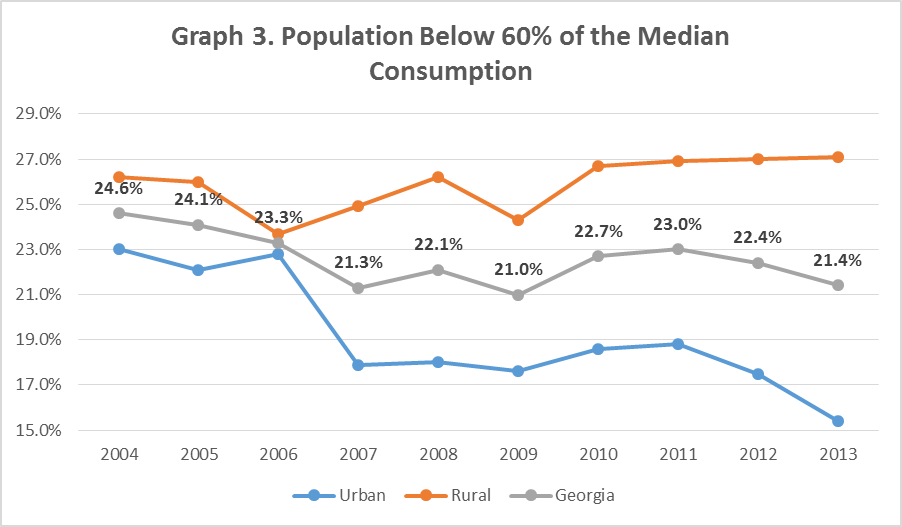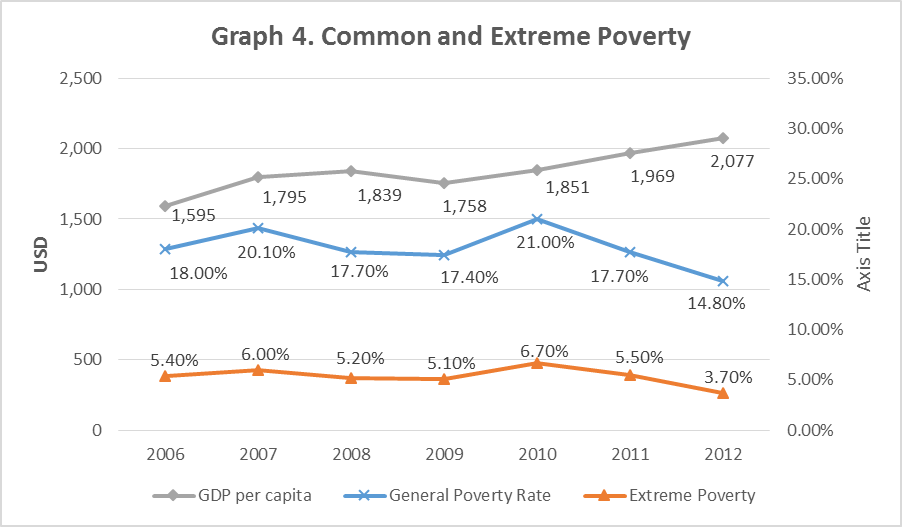Davit Onoprishvili stated that during the presidency of Mikheil Saakashvili, unemployment in Georgia did not decrease but poverty increased.
Since 2003, Georgia’s economy has been increasing at a significant pace. Particularly, the economic growth rate was 9%-11% in the period 2005-2007 but decreased in the period 2008-2009 because of the Russian-Georgian war and the world economic crisis. In the period 2010-2012, however, there was a 6%-7% growth in the real GDP. Overall, Georgia’s economy increased by 70% from 2003 to 2012.
The GNI[1]per capita, as an indicator of the welfare of a state, has also increased. The per capita income increased four times from 2003 to 2013 (from USD 910 to USD 3,560).
Source: World Bank
Per capita income, however, does not provide us with the information on how equally the income received by a country’s economic growth is distributed in its population. The Gini coefficient is necessary for assessing the equality of the income. The closer the given coefficient is to the value of 1, the more unequally the income is distributed.
The World Bank publishesinformation about the Gini coefficient. We checked the data for Georgia from the period 2003 to 2012. The Gini coefficient was fluctuating from 0.39 to 0.42 in these years. The coefficient was increasing in 2004-2005 and decreasing in 2006-2008. In 2009-2010, the Gini coefficient increased from 0.40 to 0.42 because of the deteriorated social conditions after the Russian-Georgian war and the world economic crisis. From 2011, the index started to decrease again and equalled 0.41. Therefore, it is clear that when Georgia had a high economic growth rate, the Gini coefficient was decreasing. It means that the income brought by economic growth was profitable for the poorer part of the population as well as for the middle-income and richer classes. By comparing to other countries, we can understand how large the income inequality is in the circumstances of the coefficient being 0.41. The lowest coefficients are typical for the highly developed countries of Europe, especially the Scandinavian countries. The USA, Israel, Singapore and Latin American countries are developed countries with higher Gini coefficients than Georgia.
The fact that economic growth, followed by salary and profit increase, is primarily reflected in the employed part of the population has to be taken into consideration. As for the part of the population which is unemployed or is not economically active,[2]the state distributes income among them by providing social assistance. The graph below shows the social expenditures dynamics in the period 2003-2013. According to the graph, both social expenditures and their share in the total budgetary expenditures were increasing.
Source: Ministry of Finance of Georgia
As for poverty, FactCheck has already published an article on this topic. Based upon the data of the National Statistics Office of Georgia, in the period 2007-2013 registered poverty[3]
increased from 279,000 to 436,000 people (by 56%) due to the war with Russia and the world economic crisis, on one side, and the change of the poverty calculation method, on another. In 2012, 9.7% of the population was living below the poverty line whilst the same index was 6.4% in 2007.
Registered poverty shows the number of the population receiving social assistance and so it does not reflect the full poverty picture. Graph 3 shows relative poverty.[4]Relative poverty in Georgia has decreased, but only slightly, although according to Graph 3, economic growth is reflected mainly in the urban population. In 2003, 23% of the urban population was consuming 60% or less of the median consumption whilst the same rate decreased to 15.4% in 2013. It is noteworthy that according to the relative poverty calculation method, a person is considered poor depending upon the general standard of living in the country. If the average income per capita is on the increase every year, increasingly more people will be considered poor. In contrast to this method, the poverty index decreased by 2.2% from 2004 to 2012.
Source: National Statistics Office of Georgia
The 2014 Georgia National Report on the Millennium Development Goals shows that poverty decreased significantly in 2006-2012 (Graph 4) although it remains at a high level. In this case, we have data from 2006 only but the decrease in poverty is still evident. Extreme poverty is classified separately in the report. Individuals whose everyday consumer expenditure does not exceed USD 1.25 are considered extremely poor and are closer to the definition of “misery.” In the period of 2006-2012, Georgia’s extreme poverty rate decreased from 5.4% to 3.7%.
Source: 2014 Georgia National Report on the Millennium Development Goals
As for the unemployment rate, it has been on the increase from 2003; namely, the rate equalled 11.6% in 2003 whilst it amounted to 15% in 2012. FactCheck has already published an article
about this topic. Graph 5 shows that the unemployment rate has been changing together with the country’s economic growth. It should be noted that an increase in the unemployment rate is usual for the initial stages of economic growth which is due to structural changes. The increase in the unemployment rate in 2004-2005 was mainly due to the massive dismissals of public officers. The unemployment rate started to decrease from 2006 but returned to the trend of increase owing to well-known events. Since 2010, the unemployment rate has been gradually decreasing. We may conclude that the economic growth was causing a decrease in the unemployment rate but the radically changed economic situation in the period 2008-2009 outweighed the existing positive trend in this direction.
Source: National Statistics Office of Georgia
Mr Onoprishvili also adds that Georgia was practically the only country in which the unemployment rate was not decreasing as the poverty rate was increasing. We searched for eight examples of European countries (and also worldwide) in which the economy was growing in the period 2003-2012 with unemployment rates increasing significantly as well (see below).
|
Country |
Economic Growth from 2003 to 2012 |
Unemployment Rate in 2003 |
Unemployment Rate in 2012 |
| Cyprus | 20% | 4% | 12% |
| France | 11% | 8.5% | 9.8% |
| Hungary | 8% | 5.5% | 11% |
| Iceland | 21% | 3.3% | 5.8% |
| Ireland | 14% | 4.6% | 14.7% |
| Latvia | 29% | 10.6% | 15% |
| Serbia | 27% | 16% | 23% |
| Slovenia | 16% | 6.7% | 8.9% |
Conclusion
Georgia’s economy increased by 70% in the period 2003-2012 whilst the income per capita increased four times. As for unemployment, the unemployment rate increased from 11.4% to 15% although the increase in unemployment coincided with the decrease in economic growth. It is noteworthy that the unemployment rate grew in the period 2004-2005 because of staff reduction in the public offices and the structural changes that were taking place. The assessment, according to which Georgia is the only country where unemployment was increasing together with economic growth, is inaccurate. The unemployment and economic growth rates were increasing simultaneously in various European countries.
The Gini coefficient shows that Georgia is not categorised as a country in which the income is relatively evenly distributed. Nevertheless, the Gini coefficient was not increasing throughout the last years which indicates that the incomes were increasing at the same rate for the poor, the middle-income population and the richer classes.
As for poverty, according to the number of people dependent upon social assistance, it grew from 6.4% in 2007 to 9.7% in 2012. According to the 2014 Georgia National Report on the Millennium Development Goals, poverty decreased in the period 2006-2012 whilst extreme poverty (misery, by definition) saw a significant decline from 5.4% to 3.7%. The relative poverty rate has decreased slightly.
FactCheck concludes that Mr Onoprishvili’s statement: “As the GDP and the economy were increasing during Saakashvili’s rule, Georgia was paradoxically almost the only country in which the unemployment rate was not decreasing and poverty was increasing,” is MOSTLY FALSE.
The Gross National Income differs from the Gross Domestic Product. Gross Domestic Product includes the income received from the sum of the created products and services on the territory of a state. Gross National Income encompasses the income received by the citizens of the state, including the income received abroad.
The economically active population includes all persons older than 15 years involved in labour activity or looking for a job.
The number of the population living below the poverty line receiving social assistance.
Graph 3 only shows the share of the population whose consumption is below 60% of the average consumption rate.






 “As the GDP and the economy were increasing during Saakashvili’s rule, Georgia was paradoxically almost the only country in which the unemployment rate was not decreasing and poverty was increasing.”
“As the GDP and the economy were increasing during Saakashvili’s rule, Georgia was paradoxically almost the only country in which the unemployment rate was not decreasing and poverty was increasing.”







